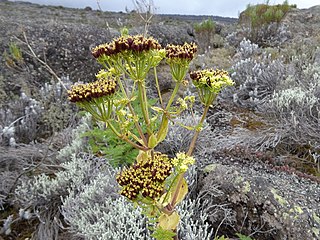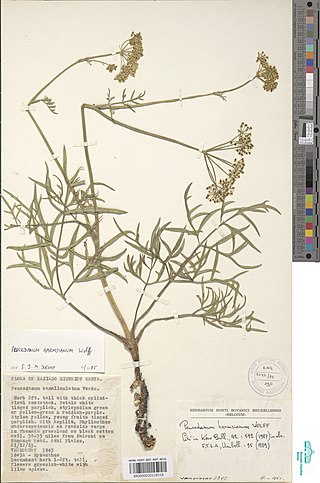
Solanum mauritianum is a small tree or shrub native to South America, including Northern Argentina, Southern Brazil, Paraguay and Uruguay. Its common names include earleaf nightshade, woolly nightshade, flannel weed, bugweed, tobacco weed, tobacco bush, wild tobacco and kerosene plant.

Phacelia crenulata is a species of flowering plant in the borage family, Boraginaceae. Its common names include notch-leaf scorpion-weed, notch-leaved phacelia, cleftleaf wildheliotrope, and heliotrope phacelia. Phacelia crenulata has an antitropical distribution, a type of disjunct distribution where a species exists at comparable latitudes on opposite sides of the equator, but not at the tropics. In North America, it is native to the southwestern United States as far east as Colorado and New Mexico, and Baja California and Sonora in Mexico. In South America, it is native to southern Peru, western Bolivia, and northern Chile.

Thunbergia alata, commonly called black-eyed Susan vine, is a herbaceous perennial climbing plant species in the family Acanthaceae. It is native to Eastern Africa, and has been naturalized in other parts of the world.

Senecio ampullaceus, also known as Texas ragwort, Texas squaw-weed, Texas groundsel, and Texas butterweed, is a species of Senecio in the family Asteraceae, receiving its Latin name ampullaceus from its flask shaped flower-head. It is recommended for landscape use in its native Texas.

Gastrodia elata is a saprophytic perennial herb in the family Orchidaceae. It is found in Nepal, Bhutan, India, Japan, North Korea, Siberia, Taiwan, and China.

Kalanchoe delagoensis, formerly known as Bryophyllum delagoense and commonly called mother of millions or chandelier plant, is a succulent plant native to Madagascar. Like other members of Bryophyllum, it is able to propagate vegetatively from plantlets that develop on its leaf margins.

Aeonium haworthii, also known as Haworth's aeonium or pinwheel, is a species of succulent flowering plant in the family Crassulaceae. It is grown as a houseplant in temperate regions. It has gained the Royal Horticultural Society's Award of Garden Merit, as has the cultivar 'Variegatum'.

Balsamorhiza deltoidea is a species of flowering plant in the sunflower tribe of the plant family Asteraceae known by the common name deltoid balsamroot. It is native to western North America from British Columbia to California, where it grows in many types of generally mountainous habitat.

Lachnagrostis filiformis is a species of grass known by the common names Pacific bent grass, New Zealand wind grass, fairy grass, or blown-grass. It is native to Australia, New Zealand, and other Pacific Islands including New Guinea and Easter Island. While it is found in a wide variety of habitats, it seems particularly invasive in areas with damp soils, such as areas near bodies of water. It has been introduced to southern Africa, the United Kingdom, Taiwan, the southern United States and Mexico.
Chylismia heterochroma is a species of evening primrose known by the common name Shockley's evening primrose. It is native to the desert slopes and woodland of eastern California and Nevada. It is a hairy, glandular annual herb growing a spindly stem up to a meter tall. There is a thick basal rosette of leaves which are mostly oval in shape and several centimeters in length, and generally no leaves higher up the stem. The inflorescence produces several small flowers with four oval petals just a few millimeters long and lavender in color with yellow-tinted bases. The fruit is a club-shaped capsule roughly a centimeter long.
Tetrapteron palmeri is a species of evening primrose known by the common name Palmer evening primrose. It is native to the western United States from California to Idaho, where it grows in several habitat types, including desert and sagebrush. It is a roughly hairy annual herb growing in a low patch on the ground, generally with no stem. The leaves are widely lance-shaped and up to about 5 centimeters long, with a few small teeth along the edges. The nodding inflorescence produces flowers with yellow petals only 2 or 3 millimeters long each and a noticeable bulbous stigma tip which may be up to a centimeter wide. The fruit is a leathery capsule around half a centimeter long with small wings near the tip.
Minuartia pusilla is a species of flowering plant in the family Caryophyllaceae known by the common names annual sandwort and dwarf stitchwort.

Afrosciadium is a genus of flowering plants belonging to the carrot family, Apiaceae. It was split from the genus Peucedanum in 2008 by P.J.D. Winter, et al.

Kalanchoe sexangularis, also known as bushveld kalanchoe, six-angled kalanchoe, or red-leaved kalanchoe, is a species of the succulent genus Kalanchoe, in the family Crassulaceae that is native to Southern Africa.

Afrosciadium harmsianum is a member of the carrot family, Apiaceae. It is a perennial tuberous herb native to east tropical Africa, while the subspecies A. h. australe is endemic to northern Tanzania.

Afrosciadium dispersum is a member of the carrot family, Apiaceae. It is a perennial tuberous herb native to tropical mountains in South Sudan, northern Uganda, and southwestern Tanzania.

Afrosciadium englerianum is a member of the carrot family, Apiaceae. It is a perennial tuberous herb, endemic to the Aberdare Mountains in Kenya.

Afrosciadium eylesii is a member of the carrot family, Apiaceae. It is a perennial tuberous herb native to southeastern Africa, from the Democratic Republic of the Congo and Tanzania to Zimbabwe and Mozambique.

Afrosciadium friesiorum is a member of the carrot family, Apiaceae. It is a perennial tuberous herb, endemic to Mount Kenya.
Afrosciadium natalense is a member of the carrot family, Apiaceae. It is a perennial tuberous herb, endemic to the KwaZulu-Natal province of South Africa.
















